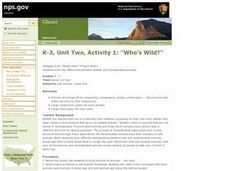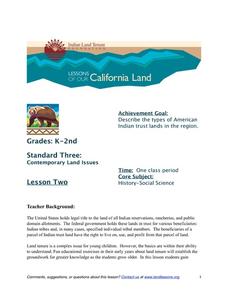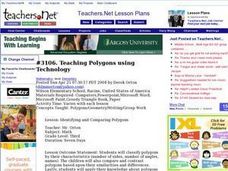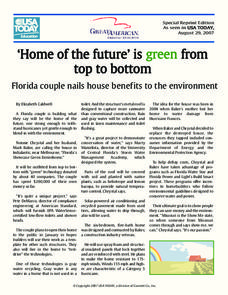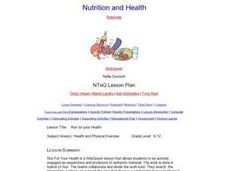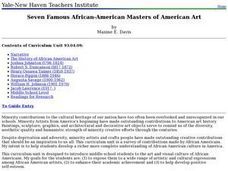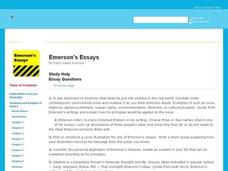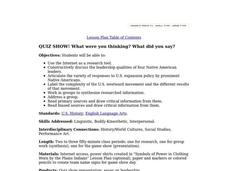Curated OER
Who's Wild?
Students explore the differences between animals of the wild and domesticated animals. In this wild animals lesson, students understand that tame animals ancestors were once wild. Students illustrate the differences by...
Indian Land Tenure Foundation
Indian Trust Lands
An important aspect of studying Native American history is understanding the nature of trust lands. Budding historians will learn that as Native Americans were removed from their home lands, trust lands were provided in the form of...
Curated OER
Protecting Our Native Forests
Students explore environmental awareness by utilizing computer technology. In this ecosystem conservation instructional activity, students read assigned text which describes the current ecological conditions of Hawaii. Students...
Curated OER
Images of the Parks
Students explore U.S. geography by completing a research project about the National Parks. In this scenery image analysis lesson plan, students identify the different national parks in our country and observe paintings and images by...
Curated OER
Teaching Polygons using Technology
Third graders utilize different types of computer programs, such as Microsoft paint and Microsoft Word to study and create different types of polygons. They use PowerPoint to create a story about a shape and others that it meets during a...
Curated OER
George Lucas and the Power of Myth
Students examine the contributions of George Lucas to society. They analyze the concept of a hero, conduct Internet research on the life of George Lucas, develop a Hero Attribute Chart, and create an artistic rendering representing the...
Curated OER
Magnificent Microscopes
Students use a microscope in a series of activities that are designed to help them explore the "invisible world" and make meaningful microscopic discoveries and learn the importance of the microscope as a tool in science and research.
Curated OER
Play on Architecture
Learners describe how buildings effect them emotionally. They recognize and describe at least five components of a particular building as metaphors for parts of the human body [Footing), heart(h), eye (window), door(mouth), face(facade),...
Curated OER
Transforming Fairy Tales
Students use the computer to write, draw, explore the Internet, and combine all of these elements. They write their own fairy tales, use computer software to create drawings of the characters for their tales and use the Internet to...
Curated OER
Arquitectura
Third graders recognize that communities change over time. In this architecture lesson, 3rd graders discuss buildings in cities and compare to the buildings in Ancient Rome. Students explore the architecture and building of...
Curated OER
Building Green
Students read an article and learn about building green. In this environment instructional activity, students visit a website to learn about Mark Baker and Nonnie Chrystal. Students write down the three events that led them...
Curated OER
Italian-American Legacy
Learners study the role of the Italian government in the migration, also their role in farm life and poverty. They discuss how the Italians supported their families and why they exited to other countries. They discuss how to begin a...
Curated OER
Inventors and Inventions Internet Hunt
In this inventors and inventions Internet hunt activity, students answer 15 questions by using the links provided for Internet research. This page includes several links to helpful web resources.
Curated OER
One Good Turn Deserves Another
Students make observations about shapes and 1-, 2-, and 3-dimensional objects. They conduct observations and make predictions regarding transformations of simple geometric shapes. They identify shapes that occur in household items.
Curated OER
Run for your Health
Young scholars, in groups, search the Internet for evidence to support the idea about a relationship between physical activities, health and well being. They create a flyer or newsletter for a campaign to recruit students to the runner's...
Curated OER
Seven Famous African-American Masters of American Art
Students examine seven different African-American artists. In groups, they use the internet to identify their contribution and techniques to the art world and examine the time period in which the artwork was produced. To end the...
Curated OER
How Do Artists Get Their Ideas? Culture and Environment as Sources of Ideas
Students share the difficulties they have in determining what to write or draw for a project. In groups, they view examples from three different artists and discuss how their personal experiences affected their art. They brainstorm a...
Curated OER
Range, Mean, Median and Mode Through the Internet
Students compute measures of central tendency. In this range, mean, median and mode lesson, students gather information on the internet, organize the data and then compute the measures of central tendency. They create a...
Curated OER
Emerson's Essays - Essay Questions
In this literature worksheet, students respond to 12 short answer and essay questions about Emerson's Essays. Students may also link to an online interactive quiz on the novel at the bottom of the page.
Curated OER
QUIZ SHOW! What were you thinking? What did you say?
Learners participate in a game show to share the information they have uncovered about the US expansion policy and how it affected Native Americans.
Curated OER
Rosa Parks Refused to Do What?
First graders listen to two books about Rosa Parks. They contribute factual information for a web. They listen to an interview with Rosa Parks on the internet, adding more information to the web. They write and illustrate a book using...
Curated OER
Water Cycle (Role of Water)
Second graders explore the role of water as a natural resource in order to conserve and protect its use for future generations.
Curated OER
School Newspaper
Fifth graders write a website based school newspaper using a variety of literary forms to present the news of the school.
Curated OER
Pangaea Puzzle: Exploring the Tectonic Forces That Shape the Earth
Sixth graders follow in the footsteps of early scientists as they put the pieces of Pangaea back together and discovered the forces that create the variety of landforms and sea-floor features of our Earth.
